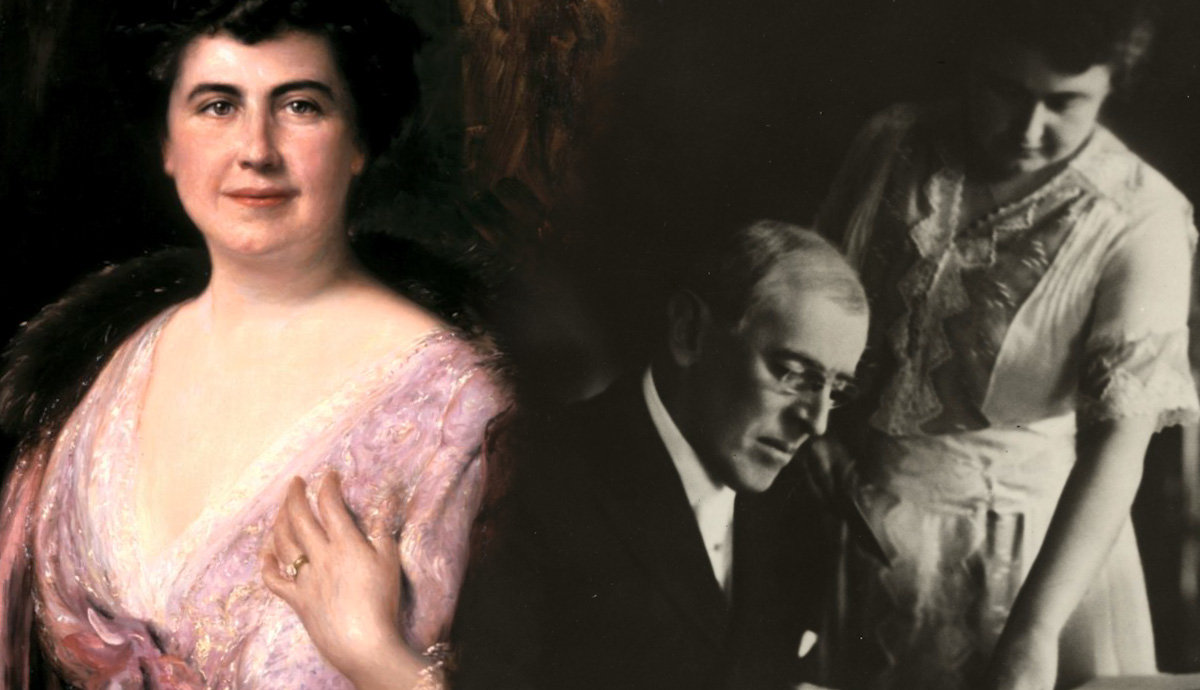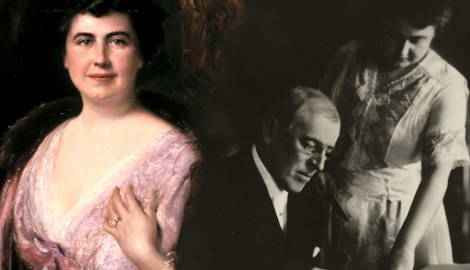
Edith Wilson, First Lady and second wife of President Woodrow Wilson, achieved many firsts during her tenure as First Lady. In fact, she was the first First Lady to travel to Europe in a political capacity. She took on many roles throughout her marriage to Woodrow and, even after his death, remained part of the political world, often attending presidential events.
Edith Wilson: Early Life and Education

Edith, born the seventh of eleven children to a prominent family, was often guided and enriched by her family. The Bolling family was one of the oldest slave-holding members of the Virginia planting elite prior to the Civil War. The Bolling household was chock full of family. Many Aunts, cousins, and grandparents lived in the large estate. Most of the women living there had lost their husbands during the war and were widows who helped to care for the family and raise the many children that lived at the estate.
The Bollings were staunch Southern Confederate supporters and proud of their heritage. Edith was taught from a young age about the Post Civil War Southern narrative (also referred to as The Lost Cause). Her family felt firmly justified in their ownership of enslaved people, believing they were content and did not desire their own freedom.

Being a daughter and the seventh child, Edith had little formal education at a young age. Unlike her brothers, she was taught basic education at home by her paternal grandmother. Due to a spine injury, her grandmother was bedridden, and Edith was tasked with caring for her as well as her 26 canaries. The two helped each other, with Edith learning reading, writing, math skills, and a hybrid version of both English and French. She also instilled in Edith the tendency to make quick judgments and hold strong opinions. As a teen, Edith was allowed to attend two different finishing schools. However, once her father realized that further education for Edith would cost him, he turned his attention to funding her brothers’ education instead. This slight left Edith with a desire for more knowledge and an eagerness to keep learning and developing.
Marriages

In 1896, Edith met a jeweler named Norman Galt on a visit to see her sister in Washington DC. They matched well and were married in April of that year, staying in DC for 12 years. She had a son in 1903 who lived only a few days. Complications from his birth left her unable to have more children. Shortly after, in 1908, Norman died unexpectedly, leaving her a widow at a young age. She used his income and estate funds to pay off all his debts and then toured Europe.
Edith returned to the United States in 1915, where she was introduced to a recently widowed president Woodrow Wilson purely by happenstance. A friendship with Wilson’s cousin, who had overtaken the hostess duties at the White House after his wife Ellen had died, led to this unexpected encounter. Wilson took a liking to Edith immediately, and it didn’t take him long to propose. In fact, the timeline was so narrow that rumors of infidelity and even murder surrounded both Woodrow Wilson and Edith Galt. While Edith did accept the proposal, she insisted on postponing any wedding plans until an official year of mourning had passed. Thus, the pair were married on December 8, 1915, at Edith’s home in Washington DC in a small ceremony of about 40 people.
Role as First Lady

Edith took her role as First Lady very seriously. As First Lady during World War I, she tried to set an example for US Citizens by following the Federal Rationing Effort at the White House. She placed sheep on the White House lawn to graze rather than mowing it. She even auctioned off the sheep wool to raise money for the American Red Cross. Her voyages to Europe with President Wilson to visit troops in 1918 and again in 1919 to sign the Treaty of Versailles helped endear her to European female royalty as well as boost America’s status as a world power, not to mention the status of the First Lady internationally.
And yet, one lingering issue was a constant for Edith. Woodrow’s health was not good, and he did little to help with that problem. His determination and sheer willpower pushed him to his limits, and it was often Edith who had to deal with the consequences. Upon his return to Washington DC after the treaty was signed, he intended to campaign the United States Senate for approval of the peace treaty and the League of Nations covenant. (The Covenant was the Charter of the League of Nations. It was signed on June 28, 1919, as Part I of the Treaty of Versailles and became effective together with the rest of the Treaty on January 10, 1920.) Instead, shortly after his return to the US, Woodrow suffered a debilitating stroke, and neither the treaty nor the covenant would be confirmed by the US Senate.
First Lady or President?

Woodrow’s stroke left him unable to run the country as a president should. Edith, along with Woodrow’s doctor and a few close friends, hid the extent of his illness from the American public. She took over many routine duties and details of the president’s executive role. From October 1919 to March 1921, she acted as a steward for Woodrow, deciding who and what was important enough for the bedridden President to deal with. While she insisted she never made a decision regarding government or public affairs, the effect was certainly noticeable. For all intents and purposes, she was fulfilling the role of president in her ill husband’s absence. In fact, she became the sole link of communication between Woodrow and his cabinet. Everything they had for him–memos, correspondence, questions, requests, etc.–went through her first.
While only a select few close to the Wilsons knew how severe Woodrow’s condition was, his absence and Edith’s insertion of “stewardship” ruffled quite a few political feathers. Yet, in her memoir, published in 1939 and aptly titled My Memoir, she was emphatic that Woodrow’s doctors had urged her to take the control she did in order to aid in his recovery.
Many of the reasons behind the stewardship were due to no laws regarding the presidential line of succession during disability. Despite multiple presidents having been assassinated at that point, none had been unable to perform their duties due to illness or disability. It would not be until 1965 that the twenty-fifth amendment was proposed by Congress, which would define the succession in the event the President died, resigned, or became unable to perform his duties.
Strong-willed and Determined

In fact, Edith insisted upon the removal of the Secretary of State Robert Lansing from the cabinet after he held Cabinet meetings without Woodrow or Edith present. She further refused British Ambassador Edward Grey the opportunity to visit the White House and President Wilson unless he dismissed an aide who had made demeaning comments about her. She filled out paperwork for the President to sign, often adding suggestions or notes to the documents. Her access to classified information, including encrypted messages, was unhindered. She often was apprised of sensitive and confidential state matters.
This conjures up thoughts of other strong women who managed day-to-day in the chaotic political world. Women such as Margaret Thatcher, Queen Elizabeth, Jeanette Rankin, Madeline Albright, and Francis Perkins. She was often called the “Secret President” and thought of as the first woman to run the American government. Aside from royalty, this really was a rare and controversial occurrence for the period. And although she didn’t initiate programs or make major decisions, she kept an eagle eye over her husband’s recovery and workload.
The End of Politics for Woodrow & Edith Wilson

Wilson spent most of the last year of his presidency reflecting on old memories with old friends. Upon his term expiration in 1921, the Wilsons retired to a home in Washington to relax at last. Woodrow would only live three more years, again leaving Edith as a widow. She would live a much longer life, even attending and riding in President John F. Kennedy’s inaugural parade. And in an odd twist of fate, Edith passed away on December 28, 1961 – the same month and day her famous husband was born.

Many of the scholarly and academic writings from the last fifty years portray Edith as overzealous and overstepping her boundaries as a woman, a wife, and a First Lady. Yet, since there was no precedent for the situation as it arose rather quickly, her interpretation of the role was not publicly opposed. Had the American public known how incapacitated President Wilson was, it’s not a far leap to assume they would have questioned her actions, just as some cabinet members did. Regardless, Edith forged a path for women and politics that is unknown to many Americans. Her determination and dedication to learning from a young age allowed her to make an impact as an adult when her husband needed her most. Her efforts to enable him to recover from his stroke while overseeing his workload are nothing short of phenomenal.







